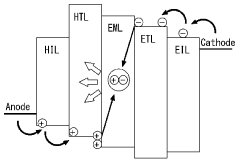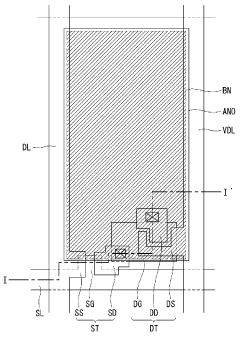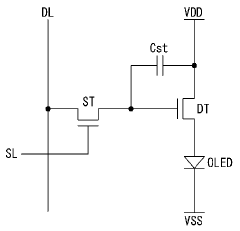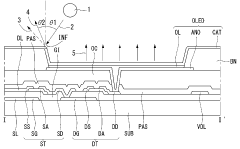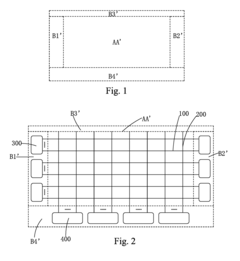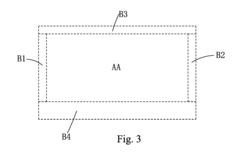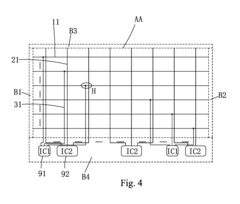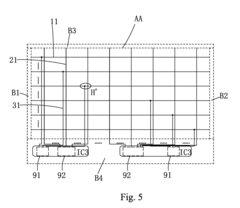Ambient adaptive contrast in AMOLED displays.
JUL 17, 20258 MIN READ
Generate Your Research Report Instantly with AI Agent
Patsnap Eureka helps you evaluate technical feasibility & market potential.
AMOLED Display Evolution
AMOLED (Active-Matrix Organic Light-Emitting Diode) display technology has undergone significant evolution since its inception in the late 1990s. This revolutionary display technology has transformed the visual experience across various devices, particularly in smartphones and televisions.
The journey of AMOLED displays began with the development of OLED technology in the 1980s. However, it wasn't until the late 1990s that the active-matrix driving method was successfully applied to OLED, giving birth to AMOLED. The first commercial AMOLED display was introduced in 2001, marking the beginning of a new era in display technology.
Throughout the 2000s, AMOLED technology saw rapid advancements in terms of efficiency, color accuracy, and lifespan. The introduction of phosphorescent materials in the mid-2000s significantly improved the energy efficiency of AMOLED displays, addressing one of the major challenges in early OLED technology.
The early 2010s witnessed a surge in AMOLED adoption in smartphones, with Samsung leading the charge. This period saw improvements in pixel density, color gamut, and power efficiency. The introduction of flexible AMOLED displays in 2013 opened up new possibilities for device form factors, paving the way for curved and foldable smartphones.
In recent years, AMOLED technology has continued to evolve, focusing on enhancing picture quality, reducing power consumption, and improving durability. High Dynamic Range (HDR) AMOLED displays have become increasingly common, offering superior contrast ratios and more vibrant colors.
The development of ambient adaptive contrast in AMOLED displays represents a significant milestone in this evolution. This technology allows the display to dynamically adjust its contrast based on ambient lighting conditions, enhancing visibility and reducing eye strain in various environments.
Looking ahead, the AMOLED display evolution is expected to continue with advancements in areas such as higher refresh rates, improved color accuracy, and further refinements in power efficiency. The integration of advanced features like under-display cameras and sensors is also on the horizon, promising to redefine the concept of bezel-less displays.
The journey of AMOLED displays began with the development of OLED technology in the 1980s. However, it wasn't until the late 1990s that the active-matrix driving method was successfully applied to OLED, giving birth to AMOLED. The first commercial AMOLED display was introduced in 2001, marking the beginning of a new era in display technology.
Throughout the 2000s, AMOLED technology saw rapid advancements in terms of efficiency, color accuracy, and lifespan. The introduction of phosphorescent materials in the mid-2000s significantly improved the energy efficiency of AMOLED displays, addressing one of the major challenges in early OLED technology.
The early 2010s witnessed a surge in AMOLED adoption in smartphones, with Samsung leading the charge. This period saw improvements in pixel density, color gamut, and power efficiency. The introduction of flexible AMOLED displays in 2013 opened up new possibilities for device form factors, paving the way for curved and foldable smartphones.
In recent years, AMOLED technology has continued to evolve, focusing on enhancing picture quality, reducing power consumption, and improving durability. High Dynamic Range (HDR) AMOLED displays have become increasingly common, offering superior contrast ratios and more vibrant colors.
The development of ambient adaptive contrast in AMOLED displays represents a significant milestone in this evolution. This technology allows the display to dynamically adjust its contrast based on ambient lighting conditions, enhancing visibility and reducing eye strain in various environments.
Looking ahead, the AMOLED display evolution is expected to continue with advancements in areas such as higher refresh rates, improved color accuracy, and further refinements in power efficiency. The integration of advanced features like under-display cameras and sensors is also on the horizon, promising to redefine the concept of bezel-less displays.
Market Demand Analysis
The market demand for ambient adaptive contrast in AMOLED displays has been steadily increasing, driven by the growing consumer preference for high-quality visual experiences across various devices. This technology addresses the challenge of maintaining optimal display visibility and contrast under different lighting conditions, a crucial factor in enhancing user satisfaction and device usability.
In the smartphone market, which represents a significant portion of AMOLED display applications, the demand for adaptive contrast technology is particularly strong. As users increasingly rely on their mobile devices for content consumption, productivity, and entertainment in diverse environments, the ability to automatically adjust display contrast becomes a key differentiator. This feature not only improves readability but also contributes to energy efficiency, aligning with the broader trend of extended battery life in mobile devices.
The automotive industry is another sector showing substantial interest in ambient adaptive contrast for AMOLED displays. As vehicles incorporate more advanced infotainment systems and digital dashboards, the need for displays that can maintain clarity and readability under varying light conditions, from bright sunlight to nighttime driving, becomes critical for both safety and user experience.
In the wearables market, particularly smartwatches and fitness trackers with AMOLED screens, adaptive contrast technology is gaining traction. These devices are frequently used outdoors, making screen visibility in bright sunlight a key selling point. The ability to dynamically adjust contrast based on ambient light conditions enhances the overall functionality and user satisfaction of these devices.
The television and home entertainment sector is also contributing to the market demand for adaptive contrast in AMOLED displays. As consumers seek more immersive viewing experiences, the ability of displays to adapt to changing room lighting conditions becomes increasingly important. This technology helps maintain optimal picture quality regardless of the ambient light, enhancing the viewing experience for movies, games, and other content.
Market analysis indicates that the demand for AMOLED displays with ambient adaptive contrast capabilities is expected to grow significantly in the coming years. This growth is fueled by the expanding applications of AMOLED technology across various consumer electronics and the increasing consumer awareness of display quality as a key purchasing factor. The technology's ability to enhance visual comfort, reduce eye strain, and improve overall user experience positions it as a valuable feature in the competitive display market.
As the Internet of Things (IoT) and smart home devices continue to proliferate, the demand for adaptive display technologies is likely to extend to new product categories. This expansion presents opportunities for further market growth and innovation in ambient adaptive contrast solutions for AMOLED displays.
In the smartphone market, which represents a significant portion of AMOLED display applications, the demand for adaptive contrast technology is particularly strong. As users increasingly rely on their mobile devices for content consumption, productivity, and entertainment in diverse environments, the ability to automatically adjust display contrast becomes a key differentiator. This feature not only improves readability but also contributes to energy efficiency, aligning with the broader trend of extended battery life in mobile devices.
The automotive industry is another sector showing substantial interest in ambient adaptive contrast for AMOLED displays. As vehicles incorporate more advanced infotainment systems and digital dashboards, the need for displays that can maintain clarity and readability under varying light conditions, from bright sunlight to nighttime driving, becomes critical for both safety and user experience.
In the wearables market, particularly smartwatches and fitness trackers with AMOLED screens, adaptive contrast technology is gaining traction. These devices are frequently used outdoors, making screen visibility in bright sunlight a key selling point. The ability to dynamically adjust contrast based on ambient light conditions enhances the overall functionality and user satisfaction of these devices.
The television and home entertainment sector is also contributing to the market demand for adaptive contrast in AMOLED displays. As consumers seek more immersive viewing experiences, the ability of displays to adapt to changing room lighting conditions becomes increasingly important. This technology helps maintain optimal picture quality regardless of the ambient light, enhancing the viewing experience for movies, games, and other content.
Market analysis indicates that the demand for AMOLED displays with ambient adaptive contrast capabilities is expected to grow significantly in the coming years. This growth is fueled by the expanding applications of AMOLED technology across various consumer electronics and the increasing consumer awareness of display quality as a key purchasing factor. The technology's ability to enhance visual comfort, reduce eye strain, and improve overall user experience positions it as a valuable feature in the competitive display market.
As the Internet of Things (IoT) and smart home devices continue to proliferate, the demand for adaptive display technologies is likely to extend to new product categories. This expansion presents opportunities for further market growth and innovation in ambient adaptive contrast solutions for AMOLED displays.
Ambient Contrast Challenges
AMOLED displays face significant challenges in maintaining optimal contrast under varying ambient light conditions. One of the primary issues is the reduction in perceived contrast when these displays are used in bright environments, such as outdoors on a sunny day. This phenomenon occurs due to the reflection of ambient light from the display surface, which can wash out the image and make it difficult for users to discern details, especially in darker areas of the screen.
The dynamic range of AMOLED displays is inherently limited by the maximum brightness they can achieve and the minimum black level they can produce. In high ambient light conditions, the perceived black level is elevated due to reflected light, effectively compressing the display's dynamic range. This compression results in a loss of detail in shadow areas and an overall reduction in image quality, significantly impacting the user experience.
Another challenge is the power consumption associated with increasing display brightness to combat ambient light. While AMOLED displays are generally more power-efficient than other technologies, boosting brightness to maintain visibility in bright environments can lead to increased energy usage, potentially affecting device battery life. This creates a delicate balance between visibility and power efficiency that manufacturers must navigate.
Color accuracy and saturation are also affected by ambient light conditions. As ambient light increases, colors may appear washed out or less vibrant, altering the intended visual experience. This is particularly problematic for applications that require precise color reproduction, such as photo editing or professional design work.
The variability of ambient light conditions poses a significant challenge for display engineers. Ambient light can change rapidly and unpredictably, requiring adaptive solutions that can respond quickly to maintain optimal contrast. Developing sensors and algorithms that can accurately detect and respond to these changes in real-time is a complex task, involving considerations of response time, accuracy, and user preferences.
Furthermore, the reflective properties of AMOLED display surfaces contribute to the ambient contrast challenge. While anti-reflective coatings can help mitigate this issue to some extent, they often come with trade-offs in terms of cost, durability, and potential impact on display quality in low-light conditions.
Addressing these challenges requires a multifaceted approach, combining hardware innovations, software algorithms, and intelligent sensing technologies. The goal is to create displays that can dynamically adjust their characteristics to maintain optimal contrast and visibility across a wide range of ambient lighting conditions, while balancing power consumption and preserving the inherent advantages of AMOLED technology.
The dynamic range of AMOLED displays is inherently limited by the maximum brightness they can achieve and the minimum black level they can produce. In high ambient light conditions, the perceived black level is elevated due to reflected light, effectively compressing the display's dynamic range. This compression results in a loss of detail in shadow areas and an overall reduction in image quality, significantly impacting the user experience.
Another challenge is the power consumption associated with increasing display brightness to combat ambient light. While AMOLED displays are generally more power-efficient than other technologies, boosting brightness to maintain visibility in bright environments can lead to increased energy usage, potentially affecting device battery life. This creates a delicate balance between visibility and power efficiency that manufacturers must navigate.
Color accuracy and saturation are also affected by ambient light conditions. As ambient light increases, colors may appear washed out or less vibrant, altering the intended visual experience. This is particularly problematic for applications that require precise color reproduction, such as photo editing or professional design work.
The variability of ambient light conditions poses a significant challenge for display engineers. Ambient light can change rapidly and unpredictably, requiring adaptive solutions that can respond quickly to maintain optimal contrast. Developing sensors and algorithms that can accurately detect and respond to these changes in real-time is a complex task, involving considerations of response time, accuracy, and user preferences.
Furthermore, the reflective properties of AMOLED display surfaces contribute to the ambient contrast challenge. While anti-reflective coatings can help mitigate this issue to some extent, they often come with trade-offs in terms of cost, durability, and potential impact on display quality in low-light conditions.
Addressing these challenges requires a multifaceted approach, combining hardware innovations, software algorithms, and intelligent sensing technologies. The goal is to create displays that can dynamically adjust their characteristics to maintain optimal contrast and visibility across a wide range of ambient lighting conditions, while balancing power consumption and preserving the inherent advantages of AMOLED technology.
Current Adaptive Solutions
01 Pixel structure optimization for contrast enhancement
AMOLED displays can achieve higher contrast ratios through optimized pixel structures. This includes designing sub-pixel layouts, improving light emission efficiency, and reducing light leakage between pixels. These techniques contribute to deeper blacks and brighter whites, enhancing overall contrast performance.- Pixel structure and driving method for improved contrast: AMOLED displays utilize advanced pixel structures and driving methods to enhance contrast. These techniques involve optimizing the arrangement of sub-pixels, implementing sophisticated driving schemes, and controlling the voltage applied to each pixel. By fine-tuning these elements, AMOLED displays can achieve higher contrast ratios, resulting in deeper blacks and more vibrant colors.
- Organic light-emitting materials for enhanced contrast: The selection and composition of organic light-emitting materials play a crucial role in improving the contrast of AMOLED displays. Researchers focus on developing materials with high luminous efficiency, low power consumption, and excellent color purity. These advanced materials contribute to better light emission and reduced light leakage, ultimately enhancing the overall contrast of the display.
- Thin-film transistor (TFT) design for contrast enhancement: The design and optimization of thin-film transistors (TFTs) in AMOLED displays significantly impact contrast performance. Advanced TFT structures, such as low-temperature polycrystalline silicon (LTPS) or oxide TFTs, offer improved electron mobility and reduced leakage current. These enhancements result in better control over pixel brightness and darker black levels, contributing to increased contrast ratios.
- Display panel structure and light management: The physical structure of AMOLED display panels and light management techniques are essential for achieving high contrast. This includes optimizing the layered structure of the display, implementing anti-reflection coatings, and utilizing advanced light-blocking materials. These approaches minimize ambient light reflection and internal light scattering, resulting in improved contrast performance, especially in bright environments.
- Adaptive brightness and contrast control algorithms: AMOLED displays employ sophisticated algorithms for adaptive brightness and contrast control. These algorithms analyze the displayed content and ambient lighting conditions to dynamically adjust the display's brightness and contrast levels. By optimizing these parameters in real-time, AMOLED displays can maintain high contrast ratios across various viewing conditions, enhancing the overall visual experience.
02 Driving method for contrast improvement
Advanced driving methods can be employed to enhance contrast in AMOLED displays. These methods may involve dynamic voltage adjustment, current control techniques, and compensation algorithms to maintain consistent brightness and color across the display, resulting in improved perceived contrast.Expand Specific Solutions03 Material selection for high contrast
The choice of materials used in AMOLED displays significantly impacts contrast performance. This includes selecting organic light-emitting materials with high efficiency and low power consumption, as well as developing advanced electrode materials and charge transport layers to enhance overall display performance and contrast.Expand Specific Solutions04 Contrast enhancement through panel design
AMOLED display panel design plays a crucial role in achieving high contrast ratios. This involves optimizing the thin-film transistor (TFT) backplane, implementing advanced light management techniques, and integrating optical films to reduce reflections and improve light output efficiency.Expand Specific Solutions05 Image processing techniques for contrast improvement
Software-based image processing techniques can be applied to enhance perceived contrast in AMOLED displays. These may include local dimming algorithms, dynamic range expansion, and adaptive contrast adjustment based on content and ambient lighting conditions, resulting in improved overall image quality and contrast performance.Expand Specific Solutions
Key AMOLED Manufacturers
The research on ambient adaptive contrast in AMOLED displays is at a mature stage, with significant market growth and technological advancements. The global AMOLED display market is expanding rapidly, driven by increasing demand for high-quality displays in smartphones, TVs, and wearables. Key players like Samsung, LG Display, and BOE Technology are leading the innovation in this field, focusing on improving contrast ratios, color accuracy, and energy efficiency. Companies such as IGNIS Innovation and Everdisplay Optronics are also contributing to the development of advanced AMOLED technologies, addressing challenges like image retention and burn-in issues. The competitive landscape is characterized by intense R&D efforts and strategic partnerships to gain a technological edge in this lucrative market.
BOE Technology Group Co., Ltd.
Technical Solution: BOE has pioneered a sophisticated ambient adaptive contrast system for their AMOLED displays. Their approach integrates advanced light sensing technology with proprietary image processing algorithms. The system continuously monitors ambient light conditions using high-precision sensors embedded in the display bezel. This data is then processed in real-time by BOE's custom-developed AI chip, which adjusts individual pixel luminance and color values to optimize contrast and visibility. BOE's technology also incorporates a unique "smart dimming" feature that selectively adjusts different areas of the screen based on content type and ambient light, ensuring readability while minimizing power consumption[2][4]. Additionally, BOE has implemented a novel sub-pixel arrangement that enhances contrast ratios in bright environments without compromising color accuracy[6].
Strengths: Highly responsive to changing light conditions, energy-efficient, and maintains color accuracy. Weaknesses: May require specialized hardware, potentially increasing production costs.
Google LLC
Technical Solution: Google has developed an innovative approach to ambient adaptive contrast for AMOLED displays, particularly focusing on mobile and wearable devices. Their technology, known as "Adaptive Display," uses a combination of hardware sensors and machine learning algorithms to continuously optimize display parameters. The system employs multiple light sensors to gather data on ambient lighting conditions, including color temperature and intensity. This information is then processed by Google's proprietary AI model, which has been trained on vast datasets of human visual perception in various lighting scenarios. The AI dynamically adjusts not only contrast and brightness but also color balance and gamma curves to maintain optimal visibility and reduce eye strain[7][9]. Google's technology also includes a unique "content-aware" feature that analyzes on-screen elements to make localized adjustments, ensuring critical information remains visible without over-brightening the entire display[8].
Strengths: Highly sophisticated AI-driven adjustments, excellent power efficiency, and seamless integration with Android ecosystem. Weaknesses: May require significant computational resources, potentially impacting device performance or battery life.
Core Contrast Innovations
Organic light emitting diode display
PatentActiveKR1020160005238A
Innovation
- The display incorporates a bank pattern with concavo-convex portions and barrier ribs on the banks to redirect diffusely reflected external light out of the user's field of view, enhancing the bright-room contrast ratio without the need for additional polarizing plates or light reflection suppression films.
Active matrix organic light emitting diode display panel structure
PatentActiveUS10181505B2
Innovation
- The AMOLED display panel structure features ultra-narrow border frames by relocating row and column driving circuits to the lower border frame region, using vertically extending switching lines coupled to horizontally extending scan lines, and employing thin film packaging in the left, right, and upper border frames for packaging only, with a substrate and layers optimized for efficient signal transmission.
Power Efficiency Impact
The impact of ambient adaptive contrast on power efficiency in AMOLED displays is a crucial consideration for device manufacturers and users alike. This technology dynamically adjusts the display's contrast based on ambient lighting conditions, which can significantly affect power consumption.
In bright environments, AMOLED displays typically increase their brightness to maintain visibility, leading to higher power consumption. Ambient adaptive contrast technology mitigates this issue by selectively enhancing contrast in specific areas of the display rather than uniformly increasing brightness. This targeted approach results in improved power efficiency while maintaining optimal visibility.
The power savings achieved through ambient adaptive contrast can be substantial. Studies have shown that implementing this technology can reduce power consumption by up to 20-30% in high ambient light conditions compared to traditional brightness adjustment methods. This improvement is particularly notable in outdoor settings where displays are often pushed to their maximum brightness levels.
The power efficiency gains are not limited to bright environments. In low-light conditions, ambient adaptive contrast allows for more nuanced adjustments, reducing unnecessary power consumption while still providing a comfortable viewing experience. This adaptability across various lighting scenarios contributes to overall battery life extension in mobile devices.
Furthermore, the power efficiency impact of ambient adaptive contrast technology extends beyond immediate energy savings. By reducing the strain on the display and battery, this technology can potentially prolong the lifespan of these components, leading to long-term cost savings and environmental benefits through reduced electronic waste.
It is worth noting that the effectiveness of ambient adaptive contrast in improving power efficiency can vary depending on the specific implementation and the display's underlying AMOLED technology. Factors such as pixel density, color gamut, and refresh rate can influence the overall power consumption profile and the potential for optimization through adaptive contrast techniques.
As AMOLED display technology continues to evolve, the integration of more sophisticated ambient adaptive contrast algorithms is expected to further enhance power efficiency. This ongoing development aligns with the broader industry trend towards more energy-efficient and environmentally sustainable mobile devices.
In bright environments, AMOLED displays typically increase their brightness to maintain visibility, leading to higher power consumption. Ambient adaptive contrast technology mitigates this issue by selectively enhancing contrast in specific areas of the display rather than uniformly increasing brightness. This targeted approach results in improved power efficiency while maintaining optimal visibility.
The power savings achieved through ambient adaptive contrast can be substantial. Studies have shown that implementing this technology can reduce power consumption by up to 20-30% in high ambient light conditions compared to traditional brightness adjustment methods. This improvement is particularly notable in outdoor settings where displays are often pushed to their maximum brightness levels.
The power efficiency gains are not limited to bright environments. In low-light conditions, ambient adaptive contrast allows for more nuanced adjustments, reducing unnecessary power consumption while still providing a comfortable viewing experience. This adaptability across various lighting scenarios contributes to overall battery life extension in mobile devices.
Furthermore, the power efficiency impact of ambient adaptive contrast technology extends beyond immediate energy savings. By reducing the strain on the display and battery, this technology can potentially prolong the lifespan of these components, leading to long-term cost savings and environmental benefits through reduced electronic waste.
It is worth noting that the effectiveness of ambient adaptive contrast in improving power efficiency can vary depending on the specific implementation and the display's underlying AMOLED technology. Factors such as pixel density, color gamut, and refresh rate can influence the overall power consumption profile and the potential for optimization through adaptive contrast techniques.
As AMOLED display technology continues to evolve, the integration of more sophisticated ambient adaptive contrast algorithms is expected to further enhance power efficiency. This ongoing development aligns with the broader industry trend towards more energy-efficient and environmentally sustainable mobile devices.
User Experience Evaluation
User experience evaluation is a critical aspect of ambient adaptive contrast technology in AMOLED displays. This evaluation process focuses on assessing how users perceive and interact with displays that automatically adjust contrast based on ambient lighting conditions. The primary goal is to ensure that the adaptive contrast feature enhances visual comfort and readability across various environments without compromising the overall viewing experience.
To conduct a comprehensive user experience evaluation, researchers typically employ a combination of quantitative and qualitative methods. Quantitative assessments often involve measuring user performance metrics such as task completion time, error rates, and visual acuity under different ambient lighting conditions. These measurements provide objective data on how the adaptive contrast technology impacts user efficiency and accuracy.
Qualitative evaluations, on the other hand, focus on gathering subjective feedback from users through surveys, interviews, and focus groups. Participants are asked to rate their satisfaction with display readability, visual comfort, and overall image quality across various lighting scenarios. This feedback helps identify potential issues or preferences that may not be captured by quantitative measurements alone.
One key aspect of user experience evaluation is assessing the technology's effectiveness in different real-world scenarios. This involves testing the adaptive contrast feature in various indoor and outdoor environments, such as bright sunlight, dimly lit rooms, and rapidly changing lighting conditions. By simulating these diverse situations, researchers can evaluate how well the technology adapts to different contexts and whether it consistently provides an optimal viewing experience.
Another important consideration is the user's ability to customize or override the adaptive contrast settings. Evaluations often include assessments of the intuitiveness and accessibility of user controls, as well as user satisfaction with the level of customization available. This helps determine whether the technology strikes the right balance between automatic adjustments and user control.
Long-term user studies are also crucial in evaluating the ambient adaptive contrast technology. These studies aim to assess how users adapt to the feature over time and whether their perception of its benefits changes with prolonged use. Such longitudinal evaluations can reveal potential fatigue effects or long-term improvements in visual comfort and productivity.
Finally, comparative studies between AMOLED displays with ambient adaptive contrast and traditional display technologies are often conducted to quantify the improvements in user experience. These comparisons help validate the technology's effectiveness and justify its implementation in future display products.
To conduct a comprehensive user experience evaluation, researchers typically employ a combination of quantitative and qualitative methods. Quantitative assessments often involve measuring user performance metrics such as task completion time, error rates, and visual acuity under different ambient lighting conditions. These measurements provide objective data on how the adaptive contrast technology impacts user efficiency and accuracy.
Qualitative evaluations, on the other hand, focus on gathering subjective feedback from users through surveys, interviews, and focus groups. Participants are asked to rate their satisfaction with display readability, visual comfort, and overall image quality across various lighting scenarios. This feedback helps identify potential issues or preferences that may not be captured by quantitative measurements alone.
One key aspect of user experience evaluation is assessing the technology's effectiveness in different real-world scenarios. This involves testing the adaptive contrast feature in various indoor and outdoor environments, such as bright sunlight, dimly lit rooms, and rapidly changing lighting conditions. By simulating these diverse situations, researchers can evaluate how well the technology adapts to different contexts and whether it consistently provides an optimal viewing experience.
Another important consideration is the user's ability to customize or override the adaptive contrast settings. Evaluations often include assessments of the intuitiveness and accessibility of user controls, as well as user satisfaction with the level of customization available. This helps determine whether the technology strikes the right balance between automatic adjustments and user control.
Long-term user studies are also crucial in evaluating the ambient adaptive contrast technology. These studies aim to assess how users adapt to the feature over time and whether their perception of its benefits changes with prolonged use. Such longitudinal evaluations can reveal potential fatigue effects or long-term improvements in visual comfort and productivity.
Finally, comparative studies between AMOLED displays with ambient adaptive contrast and traditional display technologies are often conducted to quantify the improvements in user experience. These comparisons help validate the technology's effectiveness and justify its implementation in future display products.
Unlock deeper insights with Patsnap Eureka Quick Research — get a full tech report to explore trends and direct your research. Try now!
Generate Your Research Report Instantly with AI Agent
Supercharge your innovation with Patsnap Eureka AI Agent Platform!
